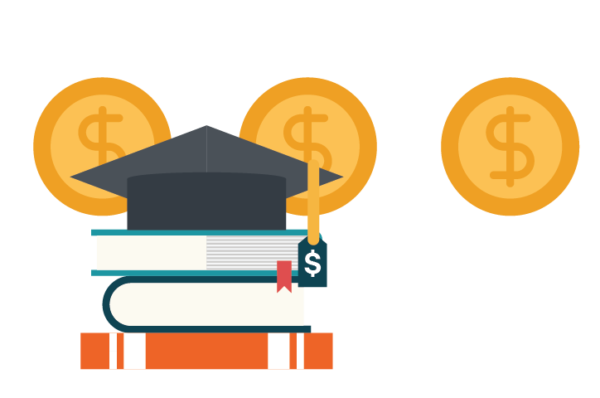Our goal is to give you the tools and confidence you need to improve your finances. Although we receive compensation from our partner lenders, whom we will always identify, all opinions are our own. Credible Operations, Inc. NMLS # 1681276, is referred to here as "Credible."
Federal student loans are backed by the U.S. Department of Education and offer unique perks that you won’t find with private student loans.
Some of the benefits of federal student loans include low interest rates, income-driven repayment options, and access to student loan forgiveness programs.
Here’s what you should know about the benefits of federal student loans:
Here are some benefits unique to federal student loans
Federal student loans offer several benefits and protections to borrowers. Here are a few unique benefits you’ll enjoy with federal student loans:
No credit check or cosigner needed to take out a federal student loan
Unlike private student loans, most federal student loans don’t require a credit check. Many undergraduate student loan borrowers don’t have an established credit history, but as long as you attend an accredited school, you could still be eligible for federal student loans.
All you need to do is complete the Free Application for Federal Student Aid (FAFSA).
Keep in mind, though, that Direct PLUS Loans do require a credit check.
Find Out: How to Qualify for Financial Aid
Lower interest rates than private student loans
The interest rates on federal student loans are set by the government, which means they’ll often be lower than interest rates on private student loans. Rates on federal student loans are fixed, meaning your rate won’t change during the life of your loan.
Here are the current federal student loan interest rates:
- Direct Subsidized Loans: 5.50%
- Direct Unsubsidized Loans: 5.50% for undergraduate borrowers; 7.05% for graduate or professional borrowers
- Direct PLUS Loans: 8.05%
Learn More: Ultimate Guide to Federal Stafford Loans
Deferment on your student loan payments is available
Student loan deferment lets you pause the payments on your student loans. You could qualify for deferment if you:
- Experience economic hardship
- Go back to school
- Are in active duty military service
- Lose your job
- Experience a major illness
- Meet other criteria
If you have subsidized loans, interest won’t accrue during a deferment period. But if you have unsubsidized loans or PLUS Loans, interest will continue to accrue while your loans are deferred.
Check Out: Federal vs. Private Student Loans
Income-based repayment plans are available
With federal student loans, you have access to income-driven repayment (IDR) plans. If you sign up for an IDR plan, your monthly payment will be based on your income — which means your monthly student loan payment could be reduced.
Plus, if you stick with your IDR plan, any remaining balance could be forgiven after 20 to 25 years, depending on the plan.
Here are the four IDR plans available:
Federal student loans can be forgiven
Federal student loans offer several potential paths to student loan forgiveness. For example, after 20 to 25 years on an IDR plan, where you are consistently making on-time payments, you might be eligible for loan forgiveness.
Or if you work for a nonprofit or government agency, you might qualify for Public Service Loan Forgiveness after only 10 years of qualifying student loan payments. If you take this route, be sure to file the necessary paperwork each year to maintain your eligibility.
Keep Reading: Everything You Need to Know About the Perkins Loan
Private student loans can help cover any funding gaps
If you’ve reached your federal student loan limits, private student loans could help to fill any funding gaps.
A few reasons why you might choose private college loans:
- Might be able to get a lower interest rate: In some cases (mainly with PLUS Loans), you might qualify for a lower interest rate on a private student loan, depending on your credit. Having a creditworthy cosigner could also help you secure a lower interest rate.
- Can apply for a loan at any time: Unlike federal student loans, which come with strict application deadlines, you can apply for a private student loan whenever you’d like.
- Higher loan limits: You might be able to borrow up to the cost of attendance for your school with private student loans.
Private student loans don’t offer the benefits of federal student loans (such as income-driven repayment or loan forgiveness), but the flexibility in loan limits and application deadlines might make a private loan worth it for you.
If you decide to take out a private student loan, be sure to shop around and consider as many lenders as possible to find the right loan for you. Credible makes this easy — you can compare your rates from our partner lenders in the table below in two minutes.
| Lender | Fixed rates from (APR) | Variable rates from (APR) |
|---|---|---|
| 2.69%+10 | 3.99%+10 | |
| 3.24%+1 | 4.48%+ | |
|
2.74%+2,3
| 3.89%+2,3 | |
| 2.85%+ | 3.66%+ | |
| 4.34%+8 | 6.78%+8 | |
| 3.29%+ | N/A | |
| 2.890%9 - 17.49%9 | 3.87%9 - 16.50%9 | |
your credit score. 100% free! Compare Now |
||
Lowest APRs reflect autopay, loyalty, and interest-only repayment discounts where available | Read our full methodology | 10Ascent Disclosures | 1Citizens Disclosures | 2,3College Ave Disclosures | 11Custom Choice Disclosures | 7EDvestinU Disclosures | 8INvestEd Disclosures | 9Sallie Mae Disclosures |
||





